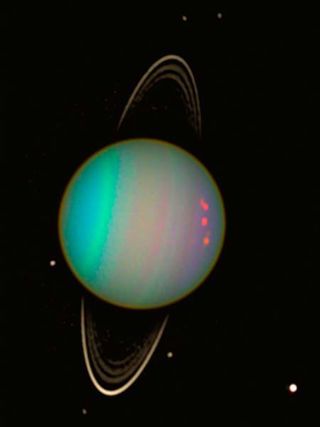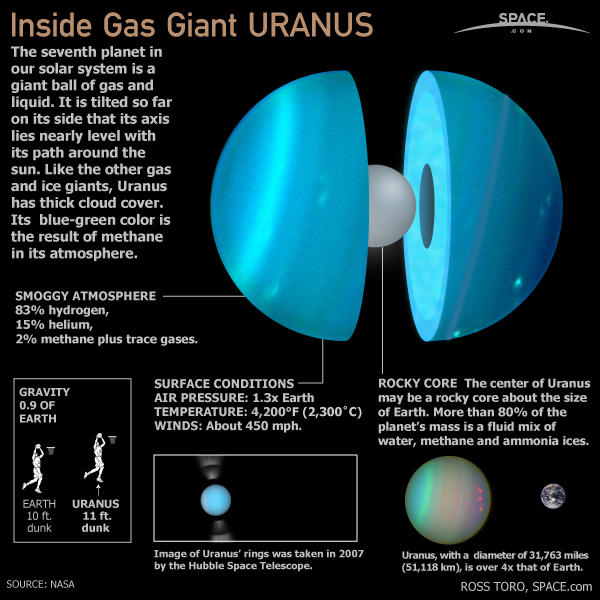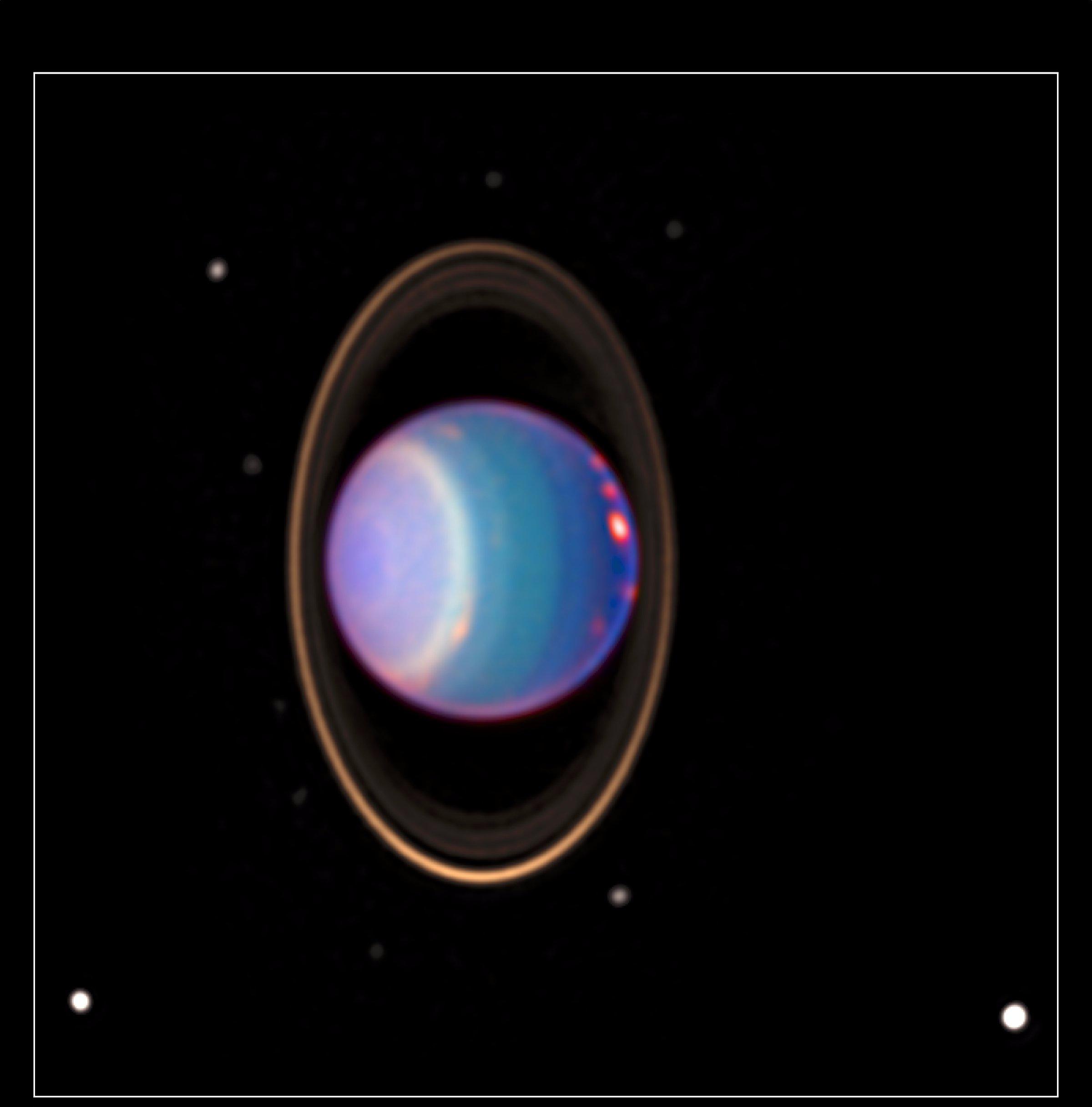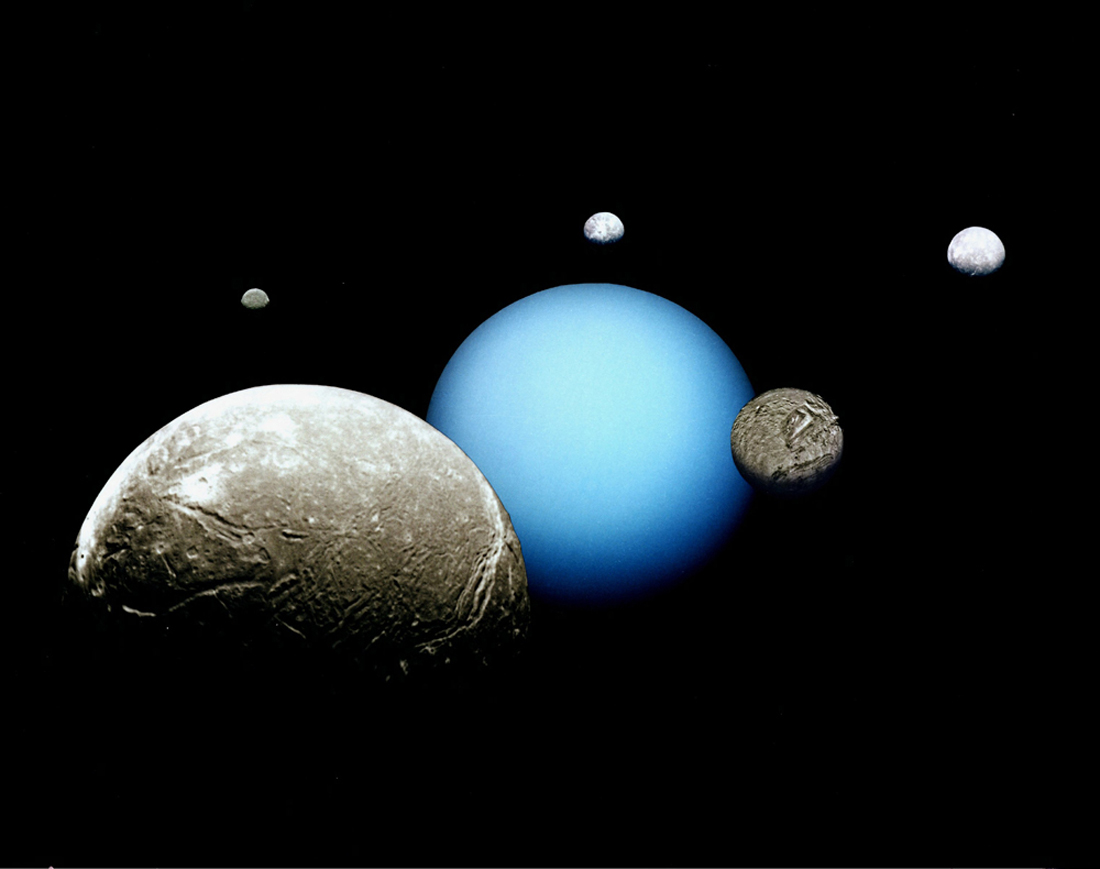What Color Is The Makeup Of Uranus
Uranus: The Ringed Planet That Sits on its Side

Uranus is the seventh planet from the sun and the first to be discovered past scientists. Although Uranus is visible to the naked center, it was long mistaken as a star because of the planet's dimness and slow orbit. The planet is also notable for its dramatic tilt, which causes its axis to betoken virtually directly at the sunday.
British astronomer William Herschel discovered Uranus on March 13, 1781, with his telescope while surveying all stars down to those nigh 10 times dimmer than can be seen by the naked middle. One star seemed different, and within a year Herschel realized the star followed a planetary orbit.
Uranus (as it was called commonly after 1850 or so) was named after the Greek sky deity Ouranos, the earliest of the lords of the heavens. It is the merely planet to exist named after a Greek god rather than a Roman i. Before the proper name was settled on, many names had been proposed for the new planet, including Hypercronius ("above Saturn"), Minerva (the Roman goddess of wisdom) and Herschel, after its discoverer. To flatter King George III of England, Herschel proposed the proper name Georgium Sidus ("The Georgian Planet"), only the thought was unpopular outside England and King George's native Hanover, Germany.
German astronomer Johann Bode, who detailed Uranus' orbit, gave the planet its ultimate name. Bode argued that as Saturn was the father of Jupiter, the new planet should be named for the father of Saturn. [Related: How Do Y'all Pronounce 'Uranus'?]
Physical characteristics
Uranus is bluish-green in color, equally a result of the methane in its mostly hydrogen-helium atmosphere. The planet is often dubbed an ice giant, since at to the lowest degree fourscore% of its mass is a fluid mix of water, marsh gas and ammonia ice.
Unlike the other planets of the solar arrangement, Uranus is tilted so far that it essentially orbits the sun on its side, with the axis of its spin nigh pointing at the star. This unusual orientation might exist due to a collision with a planet-size torso, or several small bodies, shortly after it was formed. A 2018 study suggested the colliding world could have been twice the size of Earth.
This unusual tilt gives rise to extreme seasons that final for about 20 years. This means that for nearly a quarter of the Uranian year, which is equal to 84 Earth-years, the dominicus shines directly over each pole, leaving the other half of the planet to experience a long, dark and frigid winter.
Uranus has the coldest atmosphere of whatsoever of the planets in the solar system, fifty-fifty though it is not the near distant from the sun. That's because Uranus has little to no internal rut to supplement the estrus from the sun.
The magnetic poles of most planets are typically more than or less lined upward with the axis along which it rotates, merely Uranus' magnetic field is tilted, with its magnetic centrality tipped near lx degrees away from the planet's centrality of rotation. This leads to a strangely lopsided magnetic field for Uranus, with the strength of the field at the northern hemisphere'south surface being upwards to more than than 10 times that of the force at the southern hemisphere's surface. A 2017 study suggested the lopsided nature of Uranus' magnetic field may also pb information technology to flicker on and off during every rotation (about every 17.24 hours).
Uranus' atmospheric composition past volume is 82.5% hydrogen, fifteen.2% helium and two.iii% methane. Its internal structure is fabricated up of a mantle of water, ammonia and methane ices, as well as a core of iron and magnesium silicate. Uranus' average distance from the lord's day is roughly ane.eight billion miles (ii.9 billion km), according to NASA. That'due south about xix times the distance from the World to the sun.

Uranus' climate
The extreme centric tilt Uranus experiences can requite ascent to unusual weather. As sunlight reaches some areas for the first time in years, it heats up the atmosphere, triggering gigantic springtime storms, according to NASA.
However, when Voyager two beginning imaged Uranus in 1986 at the height of summertime in its southward, the spacecraft saw a bland-looking sphere with simply about 10 or so visible clouds, leading to it to be dubbed "the almost tedious planet," wrote astronomer Heidi Hammel in "The Ice Giant Systems of Uranus and Neptune," a affiliate in "Solar Arrangement Update" (Springer, 2007), a compilation of reviews in solar system science. It was decades afterward, when advanced telescopes such equally Hubble came into play and Uranus' long seasons changed, before scientists witnessed the extreme weather on Uranus.
In 2014, astronomers got their first glimpse at summer storms raging on Uranus. Strangely, these massive storms took place seven years after the planet reached its closest approach to the sun, and it remains a mystery why the giant storms occurred later the sun'south heating on the planet was at a maximum.
Other unusual weather on Uranus includes diamond rain, which is thought to sink thousands of miles below the surface of icy behemothic planets such as Uranus and Neptune. Carbon and hydrogen are thought to shrink nether extreme estrus and force per unit area deep in the atmospheres of these planets to grade diamonds, which are then thought to sink downward, eventually settling effectually the cores of those worlds.
Yeah, Uranus has rings
The rings of Uranus were the first to be seen later on Saturn's. They were a significant discovery, considering it helped astronomers empathise that rings are a common characteristic of planets, not merely a peculiarity of Saturn.
Uranus possesses two sets of rings. The inner system of rings consists more often than not of narrow, nighttime rings, while an outer system of two more-distant rings, discovered by the Hubble Space Telescope, are brightly colored: one cerise, 1 blueish. Scientists take identified thirteen known rings effectually Uranus.
A 2016 report suggested that the rings of Uranus, Saturn and Neptune may be the remnants of Pluto-like dwarf planets that strayed too close to the giant worlds long agone. These dwarf planets were torn apart in the planets' vast gravities and are today preserved as rings.

Uranus also has moons
Uranus has 27 known moons. Instead of being named after figures from Greek or Roman mythology, its showtime four moons were named after magical spirits in English literature, such as William Shakespeare's "A Midsummer Nighttime's Dream" and Alexander Pope's "The Rape of the Lock." Since and so, astronomers have continued this tradition, cartoon names for the moons from the works of Shakespeare or Pope.
Oberon and Titania are the largest Uranian moons, and were the first to be discovered, by Herschel in 1787. William Lassell, who was as well the get-go to see a moon orbiting Neptune, discovered Uranus' next ii moons, Ariel and Umbriel. Well-nigh a century passed before Dutch-American astronomer Gerard Kuiper, he of Kuiper Chugalug fame, found Miranda in 1948.
In 1986, Voyager 2 visited the Uranian organisation and discovered an additional ten moons, all just 16 to 96 miles (26 to154 km) in diameter:Juliet, Puck, Cordelia, Ophelia, Bianca, Desdemona, Portia, Rosalind, Cressida and Belinda. Each of those moons are roughly half h2o water ice and half stone.
Since then, astronomers using Hubble and basis-based observatories have raised the total to 27 known moons, and spotting these was tricky — they are every bit little as 8 to 10 miles (12 to xvi km) across, blacker than cobblestone and about iii billion miles (4.8 billion km) abroad.
Between Cordelia, Ophelia and Miranda is a swarm of 8 small satellites crowded together so tightly that astronomers don't nonetheless understand how the niggling moons have managed to avoid crashing into each other. Anomalies in Uranus' rings pb scientists to doubtable there might still be more moons.
In addition to moons, Uranus may have a drove of Trojan asteroids — objects that share the same orbit as the planet — in a special region known equally a Lagrange point. The first was discovered in 2013, despite claims that the planet'due south Lagrange point would be too unstable to host such bodies.

Research & exploration
NASA's Voyager two was the first and every bit yet, merely spacecraft to visit Uranus. Although in that location isn't a spacecraft on its way to Uranus at the moment, astronomers regularly bank check in with the planet using the Hubble and Keck telescopes.
In 2011, the Planetary Science Decadal Survey recommended that NASA consider a mission to the icy planet. And in 2017, NASA suggested a number of potential hereafter missions to Uranus in support of the forthcoming Planetary Science Decadal Survey, including flybys, orbiters and even a spacecraft to dive into Uranus' atmosphere. Scientists are nevertheless discussing the thought. In 2019, NASA'southward Goddard Space Flight Center suggested ane possible blueprint could involve an atmospheric probe, like to the one used in Jupiter during the Galileo mission.
In 2018, an ambitious group of early-career scientists and engineers created a theoretical full mission design that would cost $i billion, and take advantage of a planetary alignment that would happen in the 2030s. At that relatively low price, the mission would perform minimal science, but could still include items such every bit a magnetometer, a methyl hydride detector and a photographic camera.
Additional resources:
- Check out this overview of Uranus, from NASA.
- Larn more nigh Uranus' numerous moons, from NASA.
- Read more virtually Uranus from the Encyclopedia Britannica.
This article was updated on July 10, 2019 by Space.com Contributor Elizabeth Howell.
Join our Space Forums to go along talking infinite on the latest missions, nighttime heaven and more! And if you have a news tip, correction or comment, let us know at: community@space.com.
What Color Is The Makeup Of Uranus,
Source: https://www.space.com/45-uranus-seventh-planet-in-earths-solar-system-was-first-discovered-planet.html
Posted by: mitchelljohicad1985.blogspot.com



0 Response to "What Color Is The Makeup Of Uranus"
Post a Comment